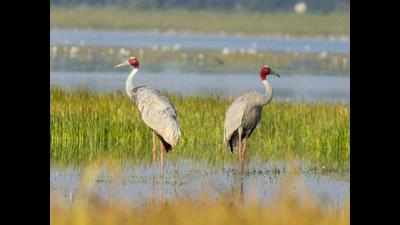- News
- City News
- nagpur News
- Sarus cranes number goes down in Gondia
Trending
This story is from June 25, 2021
Sarus cranes number goes down in Gondia
With the number of sarus cranes, the tallest of the flying birds in the world, going down in Gondia and adjoining Balaghat district of Madhya Pradesh, the NGO, Sustaining Environment and Wildlife Assemblage (SEWA), which is monitoring the birds since 2004, has called for policy-level interventions to save the bird.

A joint estimation by NGO SEWA and Gondia forest division between June 13-19, has recorded 88 sarus cranes with a margin of error of 4-5 birds.
NAGPUR: With the number of sarus cranes, the tallest of the flying birds in the world, going down in Gondia and adjoining Balaghat district of Madhya Pradesh, the NGO, Sustaining Environment and Wildlife Assemblage (SEWA), which is monitoring the birds since 2004, has called for policy-level interventions to save the bird.
A joint estimation by SEWA and Gondia forest division between June 13-19, has recorded 88 sarus cranes with a margin of error of 4-5 birds.Of this figure, 39 were in Gondia, followed by 47 in Balaghat and 2 in Bhandara.
However, in 2020, 104 sarus cranes were recorded. This included 45 in Gondia, 2 in Bhandara and 1 in Chandrapur, besides 56 in Balaghat district.
Gondia and Balaghat is divided by Bagh and Wainganga rivers and the sarus habitat is somewhat similar on both sides and hence the estimation is done on both sides. Gondia and Bhandara are the only two districts in Maharashtra where sarus cranes are found.
On reasons for the decline, Bahekar said, “There is a change in habitat as the small water wetlands are vanishing fast. Due to the illegal excavation of sand from riverbeds their roosting places are being destroyed. Besides, the tall birds are also facing threat from pesticides and electrocution due to powerlines. Destruction of their eggs is also one of the main reasons.”
Over 23 teams scanned at least 80 locations in Gondia and 70 in Balaghat. In Bhandara, honorary warden Shahid Pervez a Khan counted two birds. “There are 8-9 newborn chicks every breeding season but there is an equal number of deaths which has almost kept the sarus numbers stable,” says Bahekar.
These birds are listed in Schedule IV of the Wildlife (Protection) Act 1972 and are declared as ‘vulnerable’ in the International Union for Conservation of Nature (IUCN).
“We have over 80 ‘Sarus Mitras’ and also honour farmers for their efforts to save these birds. Yet, a conservation action plan is needed to save sarus,” says Mukund Dhurve, honorary wildlife warden of Gondia.
A joint estimation by SEWA and Gondia forest division between June 13-19, has recorded 88 sarus cranes with a margin of error of 4-5 birds.Of this figure, 39 were in Gondia, followed by 47 in Balaghat and 2 in Bhandara.
However, in 2020, 104 sarus cranes were recorded. This included 45 in Gondia, 2 in Bhandara and 1 in Chandrapur, besides 56 in Balaghat district.
Gondia and Balaghat is divided by Bagh and Wainganga rivers and the sarus habitat is somewhat similar on both sides and hence the estimation is done on both sides. Gondia and Bhandara are the only two districts in Maharashtra where sarus cranes are found.
“If policy-level interventions or a joint action plan to conserve the birds is not prepared, it will meet the same fate as the Great India Bustard (GIB). The GIB has virtually gone extinct in the state,” said Sawan Bahekar, honorary wildlife warden and president of SEWA.
On reasons for the decline, Bahekar said, “There is a change in habitat as the small water wetlands are vanishing fast. Due to the illegal excavation of sand from riverbeds their roosting places are being destroyed. Besides, the tall birds are also facing threat from pesticides and electrocution due to powerlines. Destruction of their eggs is also one of the main reasons.”
Over 23 teams scanned at least 80 locations in Gondia and 70 in Balaghat. In Bhandara, honorary warden Shahid Pervez a Khan counted two birds. “There are 8-9 newborn chicks every breeding season but there is an equal number of deaths which has almost kept the sarus numbers stable,” says Bahekar.
These birds are listed in Schedule IV of the Wildlife (Protection) Act 1972 and are declared as ‘vulnerable’ in the International Union for Conservation of Nature (IUCN).
“We have over 80 ‘Sarus Mitras’ and also honour farmers for their efforts to save these birds. Yet, a conservation action plan is needed to save sarus,” says Mukund Dhurve, honorary wildlife warden of Gondia.
End of Article
FOLLOW US ON SOCIAL MEDIA










